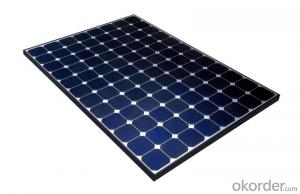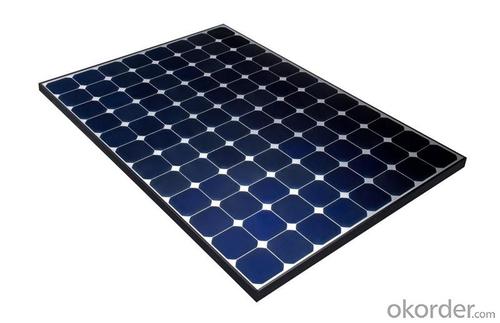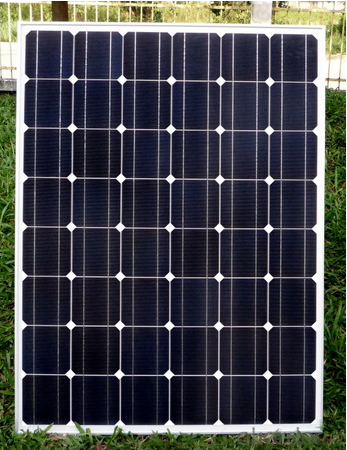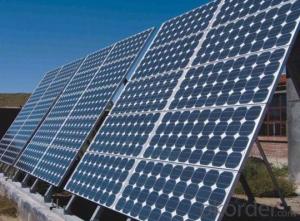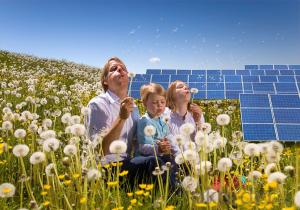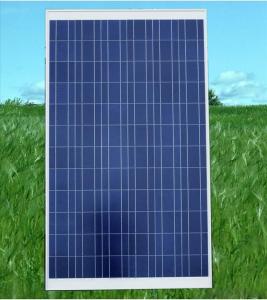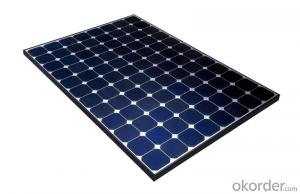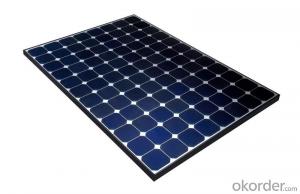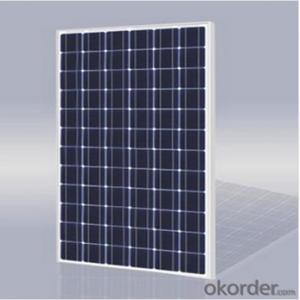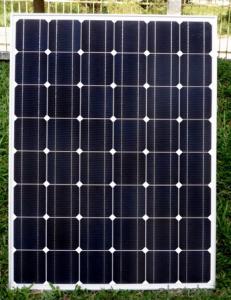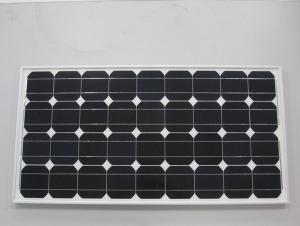CNBM Poly 215W Solar Panels Somerset with TUV UL CE Certificate for Residential
- Loading Port:
- Shanghai
- Payment Terms:
- TT OR LC
- Min Order Qty:
- 100 watt
- Supply Capability:
- 1000 watt/month
OKorder Service Pledge
OKorder Financial Service
You Might Also Like
Specification
CNBM Poly 215W Solar Panel with TUV UL CE Certificate For Residential
Introduction
Each module is rated by its DC output power under standard test conditions, and typically ranges from 100 to 365 watts. The efficiency of a module determines the area of a module given the same rated output – an 8% efficient 230 watt module will have twice the area of a 16% efficient 230 watt module. There are a few solar panels available that are exceeding 19% efficiency. A single solar module can produce only a limited amount of power; most installations contain multiple modules. A photovoltaic system typically includes a panel or an array of solar modules, a solar inverter, and sometimes a battery and/or solar tracker and interconnection wiring.
Micro-inverted solar panels are wired in parallel which produces more output than normal panels which are wired in series with the output of the series determined by the lowest performing panel (this is known as the "Christmas light effect"). Micro-inverters work independently so each panel contributes its maximum possible output given the available sunlight.[6
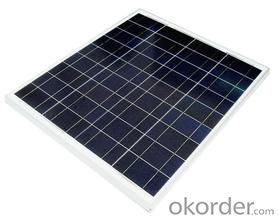
Suggested application
Home lighting business lighting,
Garden lighting, pavement lighting
Farmer household lighting
Decorative water pump
Traffic signal lighting
Industry area
Business area
Solar Power Plant
Product feature
Modules are made of Monocrystalline or Polycrystalline Silicon cell.
Materials and color of the solar panel frame: Clear anodized aluminum alloy type 6063T5 Universal frame; Silver-white color;
The output connection gathers the coupling: Selects conforms to the IEC-612615; 2005, class II, IEC61730 international standard; Airtight waterproofing binding clamp;
Module seal structure: The surface is thick, the high diaphanous rate armored glass with solar cell board special-purpose 3.2mm becomes after the high temperature lamination craft. The back selects has waterproof and anti- aged performance fine TPT materials. The entire block battery board has, the waterproofing, the anti- aging airtight and so on the fine performance;
Power tolerance: +/-3%
Packaging
International standard cartons (according to the requirements of customers)
- Q: . Does it really only cost $200 in contrast to $5000 or more?2. How much would it cost to build panels that would energize an entire average household? (washer, dryer, water heater, lights, fans, a/c)3. Is there a place to get the info on how to make them for free instead of paying E4E?4. Are the professional solar panels better? more efficient? 5. Will the electric company in So. Cal. really pay you?6. Do you have to be certified to do this professionally? or an electrician? If so what schools teach it?7. Would wind generators be of any use in So. Cal.? I mean don't you really need to get the fan spinning to get energy?8. Are there any extra unseen costs? (tools, energy converter, ect)9. How much is it to get an electrician to hook you to the grid?0. Is it better to hook to batteries or the grid? Pros, cons, why?
- Question# 5: Any state in the USA is entitle to a Federal Tax credit on their Income tax returns. Click on the source for details.
- Q: I really would like to have my own solar panel, but i don't know how. Most of the panels i have looked at are for car batteries but i'm not sure how this would be able to be transfered into electricity. I'm looking to power things like lamps, a stereo and various chargers for phones and ipods. Please explain to me how i could adapt a solar panel to my uses. Thank you.
- Yes, it can. Now what do you expect out of it? It can reduce your electric bill by some amount. That amount depends on how many solar panels you install and how sunny your days are. You have to pretty much cover a roof to get a substantial electric reduction. There are 2 companies where I live that have installed solar panels and covered most of their roofs with them. They've reduced their electric bill by about 30%. It's expensive to do this. Don't expect a fast pay back. In fact you may save more by using solar heating panels for hot water than by using solar electric panels. I think it's cheaper as well.
- Q: Are there any safety concerns with solar panels?
- Yes, there are some safety concerns with solar panels, although they are generally considered safe. The main concerns include the risk of electrical shock or fire due to improper installation or maintenance, potential harm from falling panels or debris during severe weather events, and exposure to toxic materials used in panel manufacturing. However, these risks can be minimized through proper installation, regular maintenance, and adherence to safety guidelines and regulations.
- Q: About how much would it cost to purchase and install solar panels for the average American house so that the house can be off the power grid and use the same amount of electricity as it normally does?
- And even though the better technology is out there, it is not in mass production. Perhaps one day it will be, but it is not there presently Silicon wafer based solar cells Despite the numerous attempts at making better solar cells by using new and exotic materials, the reality is that the photovoltaics market is still dominated by silicon wafer-based solar cells (first-generation solar cells). This means that most solar cell manufacturers are equipped to produce these type of solar cells. Therefore, a large body of research is currently being done all over the world to create silicon wafer-based solar cells that can achieve higher conversion efficiency without an exorbitant increase in production cost. The aim of the research is to achieve the lowest $/watt solar cell design that is suitable for commercial production.
- Q: Can solar panels be damaged by hail or other weather conditions?
- Yes, solar panels can be damaged by hail or other severe weather conditions. Hailstones can cause cracks or dents on the surface of the panels, which can affect their efficiency or even render them inoperable. Other extreme weather conditions like high winds, heavy snow, or lightning strikes can also potentially cause damage to solar panels. However, it is important to note that modern solar panels are designed to withstand a certain level of weather-related stresses and are often tested for durability.
- Q: Can solar panels be installed on asphalt shingles?
- Yes, solar panels can be installed on asphalt shingles. However, it is important to ensure that the shingles are in good condition and can support the weight of the panels. Proper installation techniques and mounting systems designed for asphalt shingles should be used to prevent any damage to the roof.
- Q: Can solar panels be used for powering outdoor recreational vehicles?
- Yes, solar panels can be used for powering outdoor recreational vehicles such as RVs, campers, and boats. They provide a convenient and eco-friendly way to generate electricity for various appliances and systems in these vehicles, including lighting, refrigeration, heating, and charging electronic devices. Solar panels can harness the sun's energy to charge batteries, which can then be used to power the vehicle's electrical needs, making it a sustainable and cost-effective option for outdoor enthusiasts.
- Q: How do solar panels withstand harsh weather conditions?
- Solar panels are designed to withstand harsh weather conditions through their durable construction materials and protective features. The panels are made with tempered glass that can handle hail, heavy rain, and snow without getting damaged. The frames are typically made of strong aluminum or stainless steel to provide stability and resistance against strong winds. Additionally, advanced solar panels have built-in drainage systems to prevent water accumulation and snow shedding technology to remove snow buildup. These design elements enable solar panels to endure and continue generating electricity even under challenging weather conditions.
- Q: I would love to put in solar panels on my roof, but how hard would it be, and how expensive? Would I be able to do the work myself, or would I have to hire a pro?Also I live in Oregon, so much of the time it is overcast, so would it really be worth it?
- Not a good idea. The reason why panels are that much more expensive than cells is that the panels themselves are not that cheap either. If you start with the cells, you'll need - mechanical protection (hail, ice, snow) - electrical protection (i.e. waterproofing - if water comes in contact with the cells and wires, you'll get electrolysis which will corrode your wires and contacts faster than you can say 'b*mmer') - that setup will need to withstand temperatures between -20 and +30 °C (only guessing, might be worse) - oh, and the side facing the sun must be transparent (as far as possible) Now as to connecting the stuff: no, it will be neither easy to connect it to the house power nor to the grid - which is why that step (at least) in all countries I know of must be done by a certified electrician. If you get it wrong and you're lucky, only _your_ inverter will explode. Regarding the power: these 4W per cell (or kW for your shed) is the peak value, i.e. with the sun shining orthogonally onto the cells on a clear day. Since this (for a fixed installation) will only be true (at most) for a few minutes on a few days each year, your overall yield will be significantly less, probably more like 4 kWh/day for each clear day for each kWpeak you install _IF_ the shed roof is oriented exactly south and inclined towards the sun's noon position at the spring/autumn equinox (i.e. inclination angle = your geographical latitude). How many clear days do you have in britain? Yes, I had a similar idea for myself - but for one thing, the registered companies I addressed apparently weren't really interested in that small fry, plus the cost of the system + setup would barely have been amortized after the expected lifetime, even taking into account the (german) governmental subsidies. If I had the money to spare, I'd rather invest in a communal solar park. Much better ROI, the large installations get much better prices (per kW) for the setup.
- Q: What makes them stop working after a while?
- You can search on solar panel failure mechanisms for scholarly works. Amorphous silicon thin-film panels go through an annealing, and power drops off after a couple years. This includes most of those flexible rubber mat type panels. That's why those are not used on serious installations. Serious panels intended for rooftop service generally come with a 25-year warranty, suggesting that the technology is more reliable than your washer, dryer, TV, computer, dishwasher, or water heater. One brand of panel had trouble about 0 years ago, but the manufacturer replaced all that were turned in, even paying shipping both ways. It was a problem with that particular model, not the technology. Our polysilicon panels have been on the roof for 3 years, now, and I've seen no sign of wear, yet, either electrically or mechanically.
Send your message to us
CNBM Poly 215W Solar Panels Somerset with TUV UL CE Certificate for Residential
- Loading Port:
- Shanghai
- Payment Terms:
- TT OR LC
- Min Order Qty:
- 100 watt
- Supply Capability:
- 1000 watt/month
OKorder Service Pledge
OKorder Financial Service
Similar products
Hot products
Hot Searches
Related keywords
